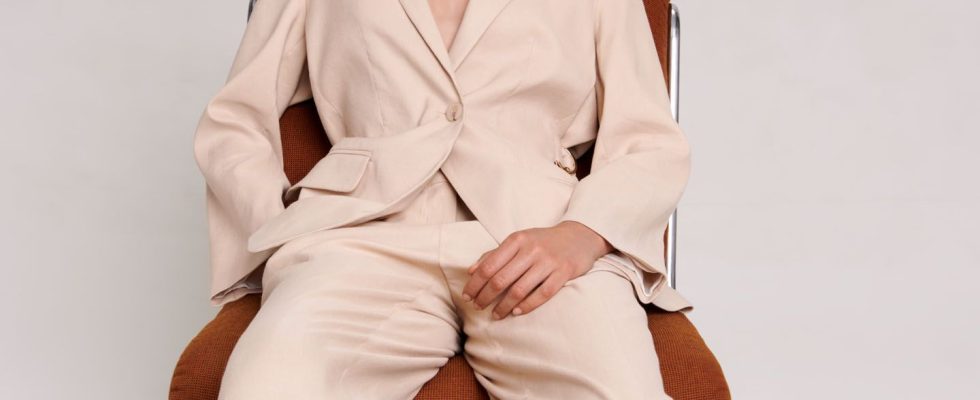Fashion designers do not (yet) possess the gift of clairvoyance. But their seasonal inspirations and their way of feeling the times sometimes say what tomorrow will bring. In the flurry of fall-winter 2023-2024 trends announced on the catwalks last February and March, the omnipresence of pieces associated with the world of work and office life sent a clear message, sounding the death knell for telework demanded by the big American bosses (Apple, Disney, Amazon, etc.). According to the oracles, this return to school in September thus marks the end of the “Covid and containment” era, traversed in the greatest disarray. Say goodbye to jogging, leggings and pajamas. Return of troops to headquarters. Every morning, you will have to get ready again…
A jacket synonymous with presence
If the skirt suit (Miu Miu, Stella McCartney), the pants (Yves Saint Laurent) and even the tie (Valentino) are part of the great return of style working girl of the 1980s and 1990s, it is above all the blazer, a totem with graphic (Louis Vuitton, Alexander McQueen, Bottega Veneta) or oversized (Courrèges, Balenciaga) shoulder pads, which confirms this impulse. Because this double-breasted jacket or not, stolen from their mother – or their father – by 20-30 year olds who wear it extra-large with mini-shorts, remains the ultimate symbol of the woman of power, of the determined manager and the dynamic framework seeking to consolidate its status and authority. Like a man in his suit. “The blazer is synonymous with presence, reliability, legitimacy and assertion of its role as a leader, develops Marion Renoux, independent stylist and fashion consultant. It establishes the respect due to the rank of the one who wears it in the organization chart of In the very formal universe of certain professional spheres, such as that of business, a woman emphasizes with him, without verbalizing it, that she knows the codes and that she is ready to assume the responsibilities assigned to her. entrusted.” Admittedly fictitious, the rise of the character embodied by actress Sarah Snook in the series Succession perfectly illustrates the key role of this garment. In this powerful family conglomerate of media and entertainment where immaculately dressed machos are wickedly elbowing their way to take control, the thirty-year-old “Shiv” Roy is asserting herself as her wardrobe goes upmarket, well helped by his monochrome blazers. “This woman is a good source of inspiration, because she chooses chic but neutral models and tones, devoid of ostentation or any outward sign of wealth such as a logo or a bright color, continues Marion Renoux. She thus marks her territory , but in a subtle and distinguished way, in line with the trend quiet luxury found in Kate Middleton. Using this feminist attribute in this vein is the best way to impose it.” With tact and firmness.
A disputed origin
But why this basic rather than another? Where does this unique aura come from? As often with statutory classics, the answer lies in its pedigree. The paternity of the blazer, of nautical origin, is subject to dispute. One version of the story has it born in the 1820s on the shoulders of members of the nautical team at St John’s College, Cambridge. Another dates it to 1837, when the captain of the ship HMS Blazer (hence the name) had her crew don double-breasted navy blue jackets during a visit from Queen Victoria. It became popular at the end of the 19th century on English and American campuses, and served as a banner for proud students practicing tennis, golf, cricket or rowing, before symbolizing the style preppy white and posh Anglo-Saxon youth. The blazer crossed the gender barrier with the feminization of work, but above all thanks to two great women’s struggles, those of the right to vote in 1910 and then that of equal pay, already fifty years later. Two great French names in fashion, Courrèges and Yves Saint Laurent, support the movement by incorporating it into their collections. These committed creators draw the figurative bases of the leading, professional and ambitious woman who explodes in the cash and Wall Street years.
Dark in color and paired with a shirt, the blazer was confined for a long time to the rigid straitjacket à la Margaret Thatcher. Then he frees himself from his cliché. Even if certain very high functions still impose this old binomial (Christine Lagarde at the head of the European Central Bank or Elisabeth Borne at that of the government). And even if you have to be called Angela Merkel or the late Elizabeth II to wear it in candy pink or chick yellow, the blazer becomes a formidable terrain of “I”. In T-shirts-jeans-sneakers, Vanessa Paradis, Carla Bruni and Charlotte Gainsbourg roll up its sleeves and make it bohemian. Their children’s generation finds it in vintage thrift stores and allows it everywhere. Above all, it is no longer reserved for the high-ranking caste. “A candidate can very well wear it during a job interview, just like a junior employee who aspires to a promotion, concludes Marion Renoux. It is a sign of consideration vis-à-vis the recruiter or the not + 1 and the mark of those who have understood that clothing is also an image issue in the current world of work.” In any case, the blazer will always be a good idea.
